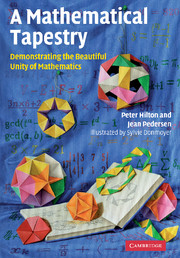Book contents
- Frontmatter
- Contents
- Preface
- Acknowledgments
- 1 Flexagons – A beginning thread
- 2 Another thread – 1-period paper-folding
- 3 More paper-folding threads – 2-period paper-folding
- 4 A number-theory thread – Folding numbers, a number trick, and some tidbits
- 5 The polyhedron thread – Building some polyhedra and defining a regular polyhedron
- 6 Constructing dipyramids and rotating rings from straight strips of triangles
- 7 Continuing the paper-folding and number-theory threads
- 8 A geometry and algebra thread – Constructing, and using, Jennifer's puzzle
- 9 A polyhedral geometry thread – Constructing braided Platonic solids and other woven polyhedra
- 10 Combinatorial and symmetry threads
- 11 Some golden threads – Constructing more dodecahedra
- 12 More combinatorial threads – Collapsoids
- 13 Group theory – The faces of the trihexaflexagon
- 14 Combinatorial and group-theoretical threads – Extended face planes of the Platonic solids
- 15 A historical thread – Involving the Euler characteristic, Descartes' total angular defect, and Pólya's dream
- 16 Tying some loose ends together – Symmetry, group theory, homologues, and the Pólya enumeration theorem
- 17 Returning to the number-theory thread – Generalized quasi-order and coach theorems
- References
- Index
6 - Constructing dipyramids and rotating rings from straight strips of triangles
Published online by Cambridge University Press: 10 November 2010
- Frontmatter
- Contents
- Preface
- Acknowledgments
- 1 Flexagons – A beginning thread
- 2 Another thread – 1-period paper-folding
- 3 More paper-folding threads – 2-period paper-folding
- 4 A number-theory thread – Folding numbers, a number trick, and some tidbits
- 5 The polyhedron thread – Building some polyhedra and defining a regular polyhedron
- 6 Constructing dipyramids and rotating rings from straight strips of triangles
- 7 Continuing the paper-folding and number-theory threads
- 8 A geometry and algebra thread – Constructing, and using, Jennifer's puzzle
- 9 A polyhedral geometry thread – Constructing braided Platonic solids and other woven polyhedra
- 10 Combinatorial and symmetry threads
- 11 Some golden threads – Constructing more dodecahedra
- 12 More combinatorial threads – Collapsoids
- 13 Group theory – The faces of the trihexaflexagon
- 14 Combinatorial and group-theoretical threads – Extended face planes of the Platonic solids
- 15 A historical thread – Involving the Euler characteristic, Descartes' total angular defect, and Pólya's dream
- 16 Tying some loose ends together – Symmetry, group theory, homologues, and the Pólya enumeration theorem
- 17 Returning to the number-theory thread – Generalized quasi-order and coach theorems
- References
- Index
Summary
Required materials
About 10 yards (10 meters) of 2-inch (5 cm) gummed mailing tape (or a longer length of wider tape if you want larger models). The glue on the tape should be the type that needs to be moistened to become sticky. Don't try to use tape that is sticky to the touch when it is dry – if you do you will find the experience very frustrating.
Two different colors of brightly colored wrapping paper or butcher paper
Scissors
Sponge (or washcloth)
Shallow bowl
Water
Hand towel (or rag)
Some big (heavy) books
Some bobby pins, or rubber bands
Preparing the pattern piece for a pentagonal dipyramid
Begin by folding some of the gummed mailing tape using the U1D1-folding procedure as shown in Section 2.3. Do this with the gummed side up, so you can see your fold lines better – and so that the paper will “curl” in the right direction when you assemble the model. Continue folding until you have 40 or more triangles. Cut or carefully tear the tape on the last fold line. Then cut off, or tear off, a strip containing 31 triangles counting from this end (that is, not from the end from which you began the folding).
Next place your strip of 31 equilateral triangles so that one end appears as shown in Figure 6.1 with the gummed side down.
- Type
- Chapter
- Information
- A Mathematical TapestryDemonstrating the Beautiful Unity of Mathematics, pp. 86 - 95Publisher: Cambridge University PressPrint publication year: 2010



